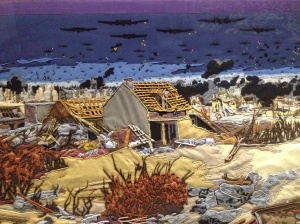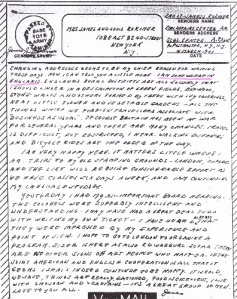The toughest part about crossing the English Channel last night was 1) the air conditioning, and 2) the WiFi – NOT that they were ineffective, but that they were highly effective, and as a result I was either too cold or very distracted. This, in combination with the gentle ocean swells made things challenging at times, but I had promised myself (and my readers) that I would not complain, so every time I was tempted to think I was the least bit uncomfortable, I thought about D-Day. What would it have been like to cross the channel in one of the boats invading Normandy? What would it have been like for my grandfather, a few weeks later, sailing with French troops? Pondering these questions helped me keep things in perspective.
D-Day was extra fresh in my mind yesterday because it turns out that Portsmouth, England (the location of my previously undisclosed location) has an excellent D-Day Museum, within walking distance of the train station. I couldn’t have planned a better use of my time in port!
http://www.ddaymuseum.co.uk/d-day/the-museum
D-Day Museum, Portsmouth, England
In addition, the museum houses the Overlord Embroidery, which has been dubbed the “modern version of the Bayeux Tapestry.”
Overlord Embroidery, Panel #30, July 1944
The short film was powerful and moving, and the exhibits gave me a real sense of what day to day life must have been like for the Allies gathering in Portsmouth and Southampton. For example, here are some examples of dried goods. I wouldn’t have noticed them, except that I overheard the woman in front of me as she turned to her friend and said, “Dried eggs! I hated dried eggs! Do you remember those?”
Dried Canned Goods & Wartime Recipes
The folks at the museum were very friendly, and I told them about my Monuments Girl Mission. I also showed them “The Monuments Men” movie shirt I was wearing, gave them my blog address, read aloud from my grandfather’s book “Survival,” and showed pictures from the NYC Film Premiere. I was pretty excited to find a captive audience.
Thinking all about D-Day inspired me to turn to my grandfather’s letters to see if I could figure out where he had shipped from. He didn’t include details, however, because of the censors. According to the museum docents, it’s very likely that he sailed from Portsmouth since it was the naval base at that time. Do any of my readers know from which port exactly a Liberty ship would have sailed?
Needless to say, my D-Day envisioning strategy worked, and I made it to St. Malo safely.





